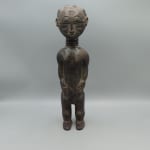Baule Figure of a Woman, 19th-20th century CE
Wood
height 33.5 cm
height 13 1/4 in
height 13 1/4 in
EL.0044
Further images
-
(View a larger image of thumbnail 1
)

-
(View a larger image of thumbnail 2
)

-
(View a larger image of thumbnail 3
)

-
(View a larger image of thumbnail 4
)

-
(View a larger image of thumbnail 5
)

-
(View a larger image of thumbnail 6
)

-
(View a larger image of thumbnail 7
)

-
(View a larger image of thumbnail 8
)

-
(View a larger image of thumbnail 9
)

-
(View a larger image of thumbnail 10
)

This wooden figurine represents a stylised version of the female form. The body is narrow and elongated, especially the torso which is almost cylindrical. Her flat feet allow her to...
This wooden figurine represents a stylised version of the female form. The body is narrow and elongated, especially the torso which is almost cylindrical. Her flat feet allow her to stand independently, and her legs are short with bulging calves. The figure’s buttocks are rounded and enlarged. Her hands rest on her abdomen, which has a very slight swelling in the centre. Her shoulders carve forward to form her breasts, which are pointed to such an extent that they are almost pyramid-shaped. Three carved lines encircle her long neck, which supports a round head. The most notable facial features are the large semi-circular eyes, which have heavy lids. At the outer corner of each eye are three raised lines, probably representing scarification marks. There are oval-shaped depressions in both cheeks, which may also be scarification marks. The nose is long, and the mouth is small and straight. Her hair is bordered by a line of pattern, and the texture is represented by pointed bumps.
This statue may be a blolo bla figure, meaning ‘spirit wife’. The Baule people believe that everybody has a spirit spouse (blolo bian is the male equivalent of blolo bla) from a different world (known as blolo), who they were married to before they entered this world. When someone is born into this world, they abandon their spirit spouse, which can make them unhappy. Spirit spouses can have an impact on a person’s successes in this life if they are angry, and therefore people dedicate a lot of effort to keeping them happy. If somebody is experiencing personal problems, they may consult a diviner-healer (known as ‘komien’) who will instruct the client to have a statue made with particular characteristics. This statue will be placed in a private area in the client’s home to be worshipped and sacrificed to, in the hope of appeasing the spirit spouse. They are designed to represent an ideal of man or womanhood, encapsulating both physical perfection and moral and intellectual achievement. Common features include scarification marks, elaborate hairstyles, and hands resting on the abdomen.
The Baule people today make up one of the largest ethnic groups in Côte d’Ivoire. It is said that they migrated to the area from Ghana in the 1750s, under the rule of Queen Pokou, who refused to join the Ashanti empire. As part of their journey, they had to cross the Komoé river, but when they reached it they were not able to find a way over. The queen’s priest advised that a noble child must be sacrificed, and so she cast her infant son into the river. Several hippopotamuses appeared, forming a bridge by which they were able to cross. The queen, grieving her child, called out ‘ba ouli’, meaning ‘the child is dead’; this phrase evolved into the name ‘Baule’ by which her descendants are known. The Baule people are traditionally farmers, living in small villages controlled by village-leaders, or kings and queens in the larger communities. Their staple food is yams, and they also grow coffee and cocoa to make a profit.
This statue may be a blolo bla figure, meaning ‘spirit wife’. The Baule people believe that everybody has a spirit spouse (blolo bian is the male equivalent of blolo bla) from a different world (known as blolo), who they were married to before they entered this world. When someone is born into this world, they abandon their spirit spouse, which can make them unhappy. Spirit spouses can have an impact on a person’s successes in this life if they are angry, and therefore people dedicate a lot of effort to keeping them happy. If somebody is experiencing personal problems, they may consult a diviner-healer (known as ‘komien’) who will instruct the client to have a statue made with particular characteristics. This statue will be placed in a private area in the client’s home to be worshipped and sacrificed to, in the hope of appeasing the spirit spouse. They are designed to represent an ideal of man or womanhood, encapsulating both physical perfection and moral and intellectual achievement. Common features include scarification marks, elaborate hairstyles, and hands resting on the abdomen.
The Baule people today make up one of the largest ethnic groups in Côte d’Ivoire. It is said that they migrated to the area from Ghana in the 1750s, under the rule of Queen Pokou, who refused to join the Ashanti empire. As part of their journey, they had to cross the Komoé river, but when they reached it they were not able to find a way over. The queen’s priest advised that a noble child must be sacrificed, and so she cast her infant son into the river. Several hippopotamuses appeared, forming a bridge by which they were able to cross. The queen, grieving her child, called out ‘ba ouli’, meaning ‘the child is dead’; this phrase evolved into the name ‘Baule’ by which her descendants are known. The Baule people are traditionally farmers, living in small villages controlled by village-leaders, or kings and queens in the larger communities. Their staple food is yams, and they also grow coffee and cocoa to make a profit.









